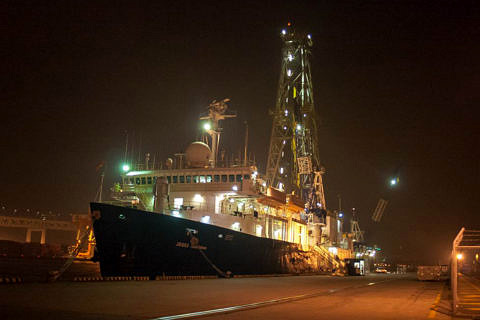FAU geologist investigates the formation of subduction zones

Core samples from an international research expedition provide insights into plate tectonics
The movement of the earth’s tectonic plates plays a fundamental role in shaping our planet. It creates mountains and oceanic trenches and can have an effect on long-term changes in the earth’s climate. Tectonic processes are an interesting field for researchers, although this research is often difficult as the most important layers of rock are often many kilometres below the surface.
During an expedition on a research vessel south of Japan, an international team of researchers – including an FAU geologist – drilled at a depth of over 6000 metres in an attempt to better understand the fundamental processes of plate tectonics.
One plate slides under another
Put simply, the earth can be divided into three layers: the molten core, the liquid mantle and the outer layer of solid crust. The crust is made up of individual plates that are around 100 kilometres thick and float on top of the mantle. If two plates move towards each other, the plate with the higher density slides underneath the other one. The increasing pressure causes water and other liquids to be pressed out of the plate, increasing its density and causing it to sink into the mantle. This process is known as subduction.
Today geologists know where the subduction zones are and there is a theoretical model explaining how they formed millions of years ago, but actual proof is rare. This is because researching the right layers of rock is very challenging technically, as they are found many kilometres below the surface of the ocean. Researchers on Expedition 351 of the International Ocean Discovery Program (IODP) have now completed a project which allowed them to gain important information.
Dr. Philipp Brandl from FAU’s GeoZentrum Nordbayern was one of the researchers on board as part of the team sampling and archiving the core samples. The team described the rocks, recording characteristics such as their mineral composition and grain size, and took the first samples to be used for determining their mineral and chemical composition while still on board the vessel. The core samples from all IODP expeditions – many hundreds of kilometres of core material – are stored in three core repositories in different parts of the world that are open to all researchers. These samples can be used to look back at the earth’s history.
Subduction starts spontaneously
‘As a result of the drilling and the samples we have obtained we hope to be able to understand how subduction actually starts. For example, how does the crust that lies above the subducting plate react when water and sediment are released, and how long does it take for a new subduction zone to form?’ Dr. Brandl explains. ‘The order of the layers and the data that we have obtain from the core samples provide the only opportunity to better understand the tectonic processes of our planet.’
On the basis of the initial analysis, the researchers have already proven, for example, that a subduction zone can form within several hundreds of thousands to a few million years – a relatively short time frame in geology. When a plate sinks spontaneously into the interior of the earth, a new crust has to form on the surface. The fundamental mechanism in this process is very similar to the mechanism behind mid-ocean ridges, where plates drift apart and magma rises and hardens, forming a new crust.
Based on the findings of the recent expedition in which researchers drilled around six kilometres into the crust, the direct influence of this on subduction zones can be chemically proven. As the crust sinks into the mantle, liquids such as water are squeezed from the crystal structure of the rock and rise into the layer of the mantle above. As a result, the melting point of the rock there decreases and a kind of magma with a special chemical signature is formed. This signature is used by geologists in the same way that criminologists use a fingerprint. During the formation of a new subduction zone this molten rock initially forms an extensive new crust before the volcanic activity is concentrated along volcanic arcs, known here as island arcs.
As a result of this expedition we will be able to understand the processes of plate tectonics much better.
With the data from this drilling operation the researchers have proven the existence of this special rock at long distances from the current plate boundaries. This enabled them to reconstruct how a subduction zone forms and over what size areas this process can happen at the same time. ‘Numerous working groups are currently evaluating the samples,’ Dr. Brandl says. ‘As a result of this expedition we will be able to understand the processes of plate tectonics much better.’
The initial results of the examinations of the core samples were published in Nature at the end of August.
Further information:
Dr. Philipp Brandl
philipp.brandl@fau.de